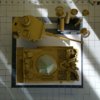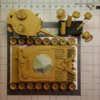C
CharleyGnarlyP290
Guest
The kit: Tamiya 1/25 scale Tiger I
Date of release: 1969
Kit features: Full interior, individual link tracks, working suspension
Yes, indeed, the kit of all kits in my youth. I could only dream of having one of these during my first foray into armor models... the summer of 19 and 76. To my budding, model-addled mind this was the ultimate kit to have. Large scale. Full interior. The legendary Tiger.
I eventually got hold of one in my young adult-hood, and built it. Didn't really turn out that great, so I shot it up with a pellet gun (and acquired a busted lip in the process, but that's another story).
A few years later, around '87 or '88 maybe, my brother bought me another one. I bought it with the intention of super-detailing it, but continued to hone my skills on 1/35 scale kits. Shortly thereafter, I got married, had some kids, and didn't do any modelling.
Fast forward to a couple of years ago and my re-entry into the hobby. While digging around in the shed, I rediscovered this kit. Water stained box, lots of dust, but still in prefect shape inside. I got it out and put it in my measly stash of upcoming kits to build.

As luck would have it a group build opportunity came up that this kit was tailor made for. A stock, out-of-the box Tamiya kit of '70s vintage. Scratch-building ok, but no after market. Ta-da! Time to get busy!



The condition of the plastic is decent considering that the molds are 46 years old. There is a bit of flash, but quite minor. Seam lines are pretty gnarly in places (more on that later), but generally not too bad.
The first page of instructions involves assembling the torsion bars to the lower hull, and assembling the wheels, idlers, and drive sprockets. The drive sprockets had some flash and seam marks, but was fairly easy to clean up thanks to narrow sanding sticks and a new Xacto blade. Idlers were clean and needed very little attention. The road wheels were a nightmare. Seams galore. Keep in mind that I generally consider road wheels to be a nightmare regardless of the age or brand of kit. I really dislike tedious stuff, and cleaning wheels is tedious. The seam lines are pretty pronounced on the wheels and took a couple of hours to clean up.
Another thing that I had to deal with and seems to be prevalent on many kits, are openings on the sponsons. For some crazy reason I can't fathom there are these weird openings towards the rear of the sponsons that are quite visible through the engine louvers.

So, I busted out the old reliable plastic sheets and cut some fillers and cemented them in.

Then I installed the torsion bars. The instruction show a nice overhead view of the interior of the hull, clearly labeling where each torsion bar goes. There are six different torsion bar moldings and they each have a specific place to go. In addition to the very clear Tamiya instructions, the inside of the hull is also marked showing where each one goes.

After that, it was cleanup time for the wheels. It took forever, but I got them done. Assembly is tricky if you don't pay attention since there are four types of pieces that make up two different sets of road wheels. I just wrote the part number on each piece as I cut it off and cleaned it.
Here's where it sits. Torsion bars installed, running gear cleaned and assembled and ready for the next steps.
Page 1 complete.

Date of release: 1969
Kit features: Full interior, individual link tracks, working suspension
Yes, indeed, the kit of all kits in my youth. I could only dream of having one of these during my first foray into armor models... the summer of 19 and 76. To my budding, model-addled mind this was the ultimate kit to have. Large scale. Full interior. The legendary Tiger.
I eventually got hold of one in my young adult-hood, and built it. Didn't really turn out that great, so I shot it up with a pellet gun (and acquired a busted lip in the process, but that's another story).
A few years later, around '87 or '88 maybe, my brother bought me another one. I bought it with the intention of super-detailing it, but continued to hone my skills on 1/35 scale kits. Shortly thereafter, I got married, had some kids, and didn't do any modelling.
Fast forward to a couple of years ago and my re-entry into the hobby. While digging around in the shed, I rediscovered this kit. Water stained box, lots of dust, but still in prefect shape inside. I got it out and put it in my measly stash of upcoming kits to build.

As luck would have it a group build opportunity came up that this kit was tailor made for. A stock, out-of-the box Tamiya kit of '70s vintage. Scratch-building ok, but no after market. Ta-da! Time to get busy!



The condition of the plastic is decent considering that the molds are 46 years old. There is a bit of flash, but quite minor. Seam lines are pretty gnarly in places (more on that later), but generally not too bad.
The first page of instructions involves assembling the torsion bars to the lower hull, and assembling the wheels, idlers, and drive sprockets. The drive sprockets had some flash and seam marks, but was fairly easy to clean up thanks to narrow sanding sticks and a new Xacto blade. Idlers were clean and needed very little attention. The road wheels were a nightmare. Seams galore. Keep in mind that I generally consider road wheels to be a nightmare regardless of the age or brand of kit. I really dislike tedious stuff, and cleaning wheels is tedious. The seam lines are pretty pronounced on the wheels and took a couple of hours to clean up.
Another thing that I had to deal with and seems to be prevalent on many kits, are openings on the sponsons. For some crazy reason I can't fathom there are these weird openings towards the rear of the sponsons that are quite visible through the engine louvers.

So, I busted out the old reliable plastic sheets and cut some fillers and cemented them in.

Then I installed the torsion bars. The instruction show a nice overhead view of the interior of the hull, clearly labeling where each torsion bar goes. There are six different torsion bar moldings and they each have a specific place to go. In addition to the very clear Tamiya instructions, the inside of the hull is also marked showing where each one goes.

After that, it was cleanup time for the wheels. It took forever, but I got them done. Assembly is tricky if you don't pay attention since there are four types of pieces that make up two different sets of road wheels. I just wrote the part number on each piece as I cut it off and cleaned it.
Here's where it sits. Torsion bars installed, running gear cleaned and assembled and ready for the next steps.
Page 1 complete.
































